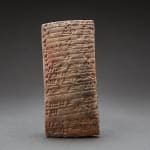Sumerian Cuneiform Tablet, 2040 BCE - 2010 BCE
Clay
2.2 x 4.72
LSO.31
Clay Tablet, with 34 Lines of Sumerian Cuneiform writin This is an administrative document from the period of the Third Dynasty of Ur, undated, but clearly from the latter part...
Clay Tablet, with 34 Lines of Sumerian Cuneiform writin This is an administrative document from the period of the Third Dynasty of Ur, undated, but clearly from the latter part of the dynasty: c, 2040-2010 BC. It is a record of plots of land assigned to soldiers who were also serfs, i.e. tied to their masters and unable to quit their posts. The plots of land were assigned to each man instead of wages. They had to work their plots and live off the results. The seasonal nature of Sumerian agriculture allowed this. Public tasks were done out of the months of intensive agricultural labour. Translation: 10 iku of released land: 1 subsistence plot for a released serf, Puzuz 10 iku: 1 subsistence plot for a serf, Ilushu-rabi, Village Malku 16 iku in the Pappasitum estate: 1 subsistence plot for a serf, Ilum-bani*, Village Pappa 10 iku: 1 subsistence plot for a serf, Elak-nu’i 10 iku: 1 subsistence plot for a serf, Lallaku, Estate Waruq-misha 10 iku, estate Shahuptiti: 1 subsistence plot for a serf, Bilil 10 iku: 1 subsistence plot for a serf, Turam-il 10 iku, estate Wwarauq-mishar: Hubanuduk, the … ma 10 iku: 1 subsistence plot for a serf, Ali’a, estate Lugal-Su’en Total: 96 ik Total: 8 subsistence plots for serf Released land for soldier Foreman: Ishkun-E’ Sumerian agricultural land was all irrigated, which is why it was so closely regulated. The irrigation was necessarily undertaken by the state. Single holders of pieces of land could not organise their own water supply. Thus the state organised the gangs of men needed as the flood rose to control the canal system and regulate the supply of water to the various areas and fields. The topsoil was light and deep, and uncontrolled rushes of water could easily carry it away. As the flood subsided in the summer the land had to be surveyed and allocated, again under state control. This is a rare document explicitly about this process. The ‘released’ serf in the first entry probably means that he was released for the time necessary to cultivate the plot, not that he was no longer a serf. No doubt one is to understand the same with all nine (!) men. An iku was about 3530 square metres.
* This individual is named in tablet 29. The fact that his son is named there as Mr Ni-etaga (serfs are not usually named) may indicate that his father had been granted freedom from serfdom – or otherwise become a man of social substance – in the intervening period. This information has implications for ascertaining a more exact date for the present tablet: it must pre-date 2032 BC, and probably dates to the mid/late 2040s BC. LSO.
* This individual is named in tablet 29. The fact that his son is named there as Mr Ni-etaga (serfs are not usually named) may indicate that his father had been granted freedom from serfdom – or otherwise become a man of social substance – in the intervening period. This information has implications for ascertaining a more exact date for the present tablet: it must pre-date 2032 BC, and probably dates to the mid/late 2040s BC. LSO.



